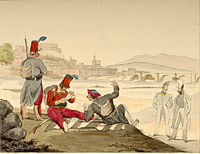
Chapelgorris
Encyclopedia

Chapelgorris were a type of volunteer unit during the First Carlist War
First Carlist War
The First Carlist War was a civil war in Spain from 1833-1839.-Historical background:At the beginning of the 18th century, Philip V, the first Bourbon king of Spain, promulgated the Salic Law, which declared illegal the inheritance of the Spanish crown by women...
, raised at the beginning of the war in the province of Guipúzcoa. They fought against the Carlists.
A soldier of the British Legion
British Legion (1835)
The Auxiliary Legion or the British Legion of the Spanish Legion existed from 1835 to 1837. It was a British military force sent to Spain to support the Liberals and Queen Isabella II of Spain against the Carlists in the First Carlist War.-History:Under the Quadruple Alliance Great Britain had...
called them a "half-wild soldiery" who "possess the same knowledge of the country, with the war-like habits and activity of the Carlists themselves, by whom they are held in considerable dread."
The Chapelgorris were formed in battalions of 700-800 men, and were officered mainly by Basques
Basque people
The Basques as an ethnic group, primarily inhabit an area traditionally known as the Basque Country , a region that is located around the western end of the Pyrenees on the coast of the Bay of Biscay and straddles parts of north-central Spain and south-western France.The Basques are known in the...
. At first irregular troops, they were later considered a regular corps.
They were called officially Free Forces (tropas francas) –for example, la Tropa franca de caballería de Ausejo (Free Forces of Cavalry of Ausejo) - but were disparagingly called Peseteros (which can be roughly translated as "money whores") by the Carlists, since they received one peseta
Spanish peseta
The peseta was the currency of Spain between 1869 and 2002. Along with the French franc, it was also a de facto currency used in Andorra .- Etymology :...
per day, though this payment was not standard and varied in nature from province to province. When Baldomero Espartero received command of the Isabeline forces, he incorporated the Chapelgorris into his own troops; it is at that time that they received their red shako
Shako
A shako is a tall, cylindrical military cap, usually with a peak or visor and sometimes tapered at the top...
s.
The wore a long gray capote or cloak; a red cap or beret
Beret
A beret is a soft, round, flat-crowned hat, designated a "cap", usually of woven, hand-knitted wool, crocheted cotton, or wool felt, or acrylic fiber....
; a small canvas bag. For weapons they used a bandolier
Bandolier
A bandolier or a bandoleer is a pocketed belt for holding ammunition. It was usually slung over the chest. In its original form, it was common issue to soldiers from the 16th to 18th centuries. This was very useful for quickly reloading a musket....
; a bayonet
Bayonet
A bayonet is a knife, dagger, sword, or spike-shaped weapon designed to fit in, on, over or underneath the muzzle of a rifle, musket or similar weapon, effectively turning the gun into a spear...
; and a carbine
Carbine
A carbine , from French carabine, is a longarm similar to but shorter than a rifle or musket. Many carbines are shortened versions of full rifles, firing the same ammunition at a lower velocity due to a shorter barrel length....
. While in full dress, they wore a high cylindrical red shako, as well as blue jackets embroidered with yellow lace and studded with silver bells and ornaments. However, after they became associated and attached with the British Legion, they adopted British uniforms, including the red coats of the British soldier. They are sometimes incorrectly called Carlist troops due to their red caps; however, the only Carlist troops who had permission to wear this was the battalion known as Guías de Navarra
Guías de Navarra
The Guías de Navarra were a Carlist battalion of the First Carlist War, created by Zumalacárregui in 1834.Their name was a misnomer: they were neither Navarrese nor guides, but captured Liberal troops from La Mancha, Valencia, Andalusia and other places who had been made prisoners at the Battle of...
(Navarre Guides), an honor granted to them by Zumalacárregui.
An unflattering description of them states that:
A vivid description of a fight between a Carlist and a Chapelgorri survives: "They wrestled for a few moments, but the Chapelgorri was strongest and stabbed the Carlist, at the same time seizing the side of his face in his teeth, and tearing it like a wolf: even when he had torn one mouthful, and the Carlist still writhing, he bit again and shook the head of the vanquished foe till his own face was besmeared with blood.”
They participated in the First Battle of Arquijas
First Battle of Arquijas
-Opening shots:The battle began when Liberal forces found Carlist general Tomás de Zumalacárregui waiting at the bridge of Arquijas over the Ega River in Navarre; about the middle of the day, some gunshots were exchanged between the several advanced posts....
(1834).
Chapelgorris and British troops captured by the Carlists were often tortured or immediately executed. In contrast, some Liberal troops of the line were saved by virtue of the Eliot treaty
Lord Eliot Convention
The Lord Eliot Convention, or simply the Eliot Convention or Eliot Treaty , was an April 1835 agreement brokered by Edward Eliot, 3rd Earl of St Germans between the two opposing sides of the First Carlist War...
, which called for the exchange of prisoners rather than their immediate execution.
External links
- Txapelgorris, 19th Century's militar history in the Basque Country.
- Txapelgorris in the Spanish-language Auñamendi Encyclopedia.

